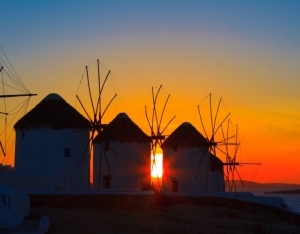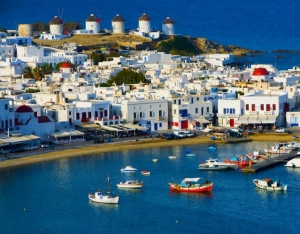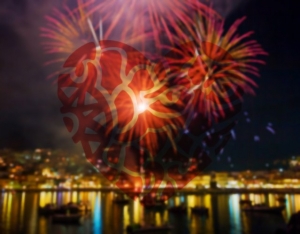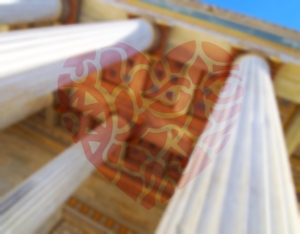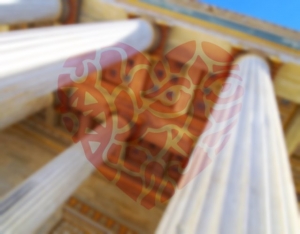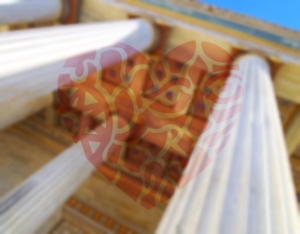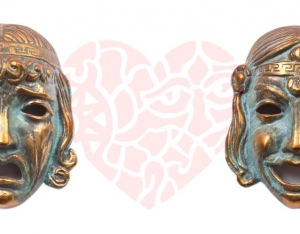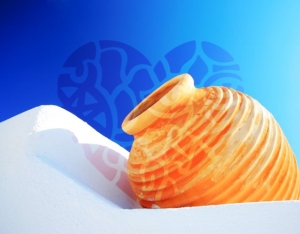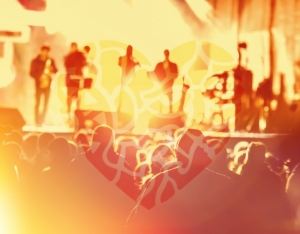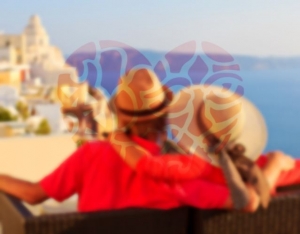Thodoris Bgenopoulos
Mykonos, just like the entire Greece, has its own haunting myths. According to one of them, the island was a rock thrown by god Poseidon in order to bury the Giants underneath, when the Clash of the Titans was taking place. Another myth has it that Mykonos took its name from the namesake son of the king of Delos, Anio.
Archaeological research and the findings in Ftelia reveal that the island of Mykonos was first inhabited around the fifth millennium BC. The Phoenicians and the Carians are considered to be the first settlers, while the island would later be colonized by Ions coming from Attica and led by Hippoclus.
In antiquity the fate of Mykonos was inextricably linked to that of the sacred island of Delos. Delos' prime actually brought on Mykonos a great financial gain, as it functioned as a station for visitors before arriving at Delos, and after its destruction Mykonos was also driven into obscurity.
After the subjugation of Athens to the Macedonians, Mykonos follows the course of the rest of Greece and is set under Macedonian,then Roman and then Byzantine rule.
Mykonos becomes the property of the Venetian family Gkizi when on Franks on 1204, and remains in their hands until bequeathed to the Republic of Venice, because of the absence of descendants. In 1537 Mykonos is despoiled by the notorious Barbarossa. A large number of residents is led into slavery, while those fleeing are now settling in Tinos.
During the Ottoman rule, Mykonos, exploiting the privileged status enjoyed by the Cyclades, prospers. The island grows economically thanks to shipping, trade and piracy, being a base for the notorious pirates of the Aegean.
During the "Orloff revolt" Mykonos is conquered by the Russians, who keep hold of it from 1770-1774 until the Treaty of Küçük Kaynarca.
With the outbreak of the 1821 revolution, Mykonos joins its fleet with the rest of Greece's against the Turks. Heroic figure of the era was the legendary Manto Mavrogenous, who provided her entire fortune to the needs of the Greek Nation's struggle. The liberation from the Turks finds Mykonos as a typical Cycladic island, until the mid-20th century. It is then discovered by the first visitors-tourists, who fall in love at first sight with the place and soon convert it to the top tourist destination it is today.
Mykonos is probably the most known Aegean island, belonging to Cyclades. It is a top tourist destination for vacations and that is exactly how the 10.000 residents of the island multiply each summer. Mykonos stretches out to 86.125km2 and the length of its seashore is more than 80 km. Chora is the capital of the island, located in its west side, while the islands Delos and Rinia are under its administration. Tourism in Mykonos had already flourished from the mid 20th century (and quite rapidly we may say), luring millions of visitors on the island, with top celebrities and figures among them.
From Mykonos you can see the island of Tinos to the north, Syros to the west, Paros and Naxos to the south and the island of Ikaria in the very east. Mykonos has an almost triangular shape, with a maximum length of about 14 km and a width of 10. The seashores shape gulfs that penetrate deep into the shore, with most important those in Chora, Panormos and Ornos. The island has mostly hills and granite is the dominant rock. The terrain is rugged, rocky and slightly smooth while the morphology of the island is mountainous or hilly. The highest peaks of the island are Prophet Elias in Ano Mera (341m.) and the two adjacent peaks, Vardies (372m.) and the second Prophet Elias (386m.) in the north of Chora.
The climate is temperate Mediterranean with the characteristic Cycladic winds that make their appearance especially in July and August. In the past, residents were intensively involved in agriculture, livestock and fisheries, something also carried out today, even though in a lesser extent due to the immense focus on tourism.
Arta, like every other place in Greece, maintains its own traditions and customs, which visitors have the chance to get to know through various events.
In Arta, the women's masquerade is organized during the carnival. It is a parade of masked local women that offer a unique show. The women's carnival is a tradition maintained since the time when the city of Arta was dominated by Venice and is definitely worth watching.
Easter in Arta, as throughout Greece, is a once in a lifetime experience not to be missed. The procession of the Epitaph, the Resurrection of Christ with the following fireworks and of course the Eastern table, will undoubtedly remain deeply etched in the memory of every visitor. On Holy Thursday a big fire is lit in the churchyard of St. Theodora church in Arta, which is said to represent the fires that were lit outside the palace of Pontius Pilate by the disciples of Jesus Christ after his arrest.
Apart from Easter there are many more festivals and celebrations mainly religious, yet full of dancing, singing and feasting. Some of them are:
- March 11, St. Theodora in Arta (patron)
- August 15, in many villages of the region
- End of September, festival with small shops and goods, Arta
In June many events are organized in Arta, to celebrate the anniversary of the city's liberation from the Turks. Also, in the village Kommeno events are organized the week before mid-August, to honor the memory of the people who were executed by the Nazi troops on August 16, 1943, a fact that went down in history as the Massacre of Kommeno.
The Historical Museum "Skoufa" is located in the city of Arta.
The Historical Museum "Skoufa"aims at covering the history of Arta from the ancient times up until today. Each room of the museum is dedicated to an era of the city and through scenographic compositions, the visitor learns about the history of Arta in a simple and understandable way.
From the hall of ancient Amvrakia, dominated by King Pyrrhus, you can pass to the byzantine room and then enjoy a tour of the castle of Arta, which is a creation of the Komnenos family. Following on, there is a room dedicated to the era of the Ottoman occupation, and of course a section dedicated to the famous Bridge of Arta.
Finally, one of the museum rooms is the office of Petros Garoufalias, a greek politician from Arta that has donated a lot to the museum and it is thus full of his personal belongings.
The museum is organized and operated by the particularly active Musical Association "Skoufas» (www.skoufas.gr), which since 1896, when it was first founded by prominent citizens of Arta, has a leading role in the cultural life of the city. Under the auspices of the club also operate the Folklore museum "Skoufa" and the Library of Arta, with over 25,000 book volumes.
Historical museum "Skoufa": Address, Skoufa square, opposite to the byzantine church of Panagia Parigoritisa, Arta
More information about the Historical Museum "Skoufa" you can find on the number 26810 22795.
The Folklore museum "Skoufa" is located in Arta, right next to the famous Bridge of Arta.
The Folklore museum "Skoufa" is hosted in a building that is considered an attraction itself, due to its unique history. The building, constructed in 1864 in an Austrian architect's drawings, served in the beginning as an outpost of the bridge. When after 1881 the border between Greece and the Ottoman Empire was right in the middle of the bridge of Arta, this building served as a border outpost.
Since 1983 the building houses the Folklore museum "Skoufa", aiming to give prominence to the local tradition. In the museum, visitors will find reconstructions of local peoples' daily life, enriched with tools, utensils and other items. Moreover, in the museum you can see traditional costumes, carnival costumes and a room dedicated to the famous Bridge of Arta.
The museum is organized and operated by the particularly active Musical Association "Skoufas» (www.skoufas.gr), which since 1896, when it was first founded by prominent citizens of Arta, has a leading role in the cultural life of the city. Under the auspices of the club also operate the Historical Museum and the Library of Arta, with over 25,000 book volumes.
Folklore museum "Skoufa": Address, Palia Gefira Artas, Arta.
More information about the Folklore Museum "Skoufa" you can find on the number 26810 22192.
The Archaeological Museum of Arta is in Arta City.
The Archaeological Museum of Arta is located on the banks of Arachthos river, very close to the well known Bridge of Arta. The museum building was completed in 2006 to house the archaeological collection of Arta, with archaeological finds from Arta and the surrounding area, which until then could be found in Parigoritisa Monastery.
The halls of the museum, the total area of which is over 1500 square meters, host findings discovered during excavations in the two ancient cemeteries of the city and in ancient public buildings such as the theater and the temple of Apollo.
The exhibits of the museum are divided into three major sections relating to public life, private life and the burials of residents. In the Archaeological Museum of Arta visitors can admire:
- Figurines, guns and other small items
- Clay and bronze vases
- Gold, silver and bronze jewelry
- Tombstones and parts of buildings
These and many other exhibits give us a clear insight into the lifestyle and habits of the ancient inhabitants of the region.
Archaeological Museum of Arta: Address, "Trigono" area, Arta.
More information concerning the Archaeological Museum of Arta you can find in http://www.artasmuseum.gr and the number 26810 21191.
Arta is a city with high esteem for theater. Those who choose to spend their vacations there, will have the opportunity to watch many worthy dramatic performances.
During the summer, theater performances for adults and children are hosted in a great place with breathtaking views, in the Municipal theater of Arta's Castle.
Moreover, the Independent Theatre Group of Arta (ATHOA) has contributed significantly to the theater of Arta in general. Since 1993 that it was founded, it still presents its own plays and projects every year in its own space during winter and in the open local theaters in summer.
Theatrical performances are also hosted in the private theater room, with a capacity of 300 seats, of the "Skoufas" association (www.skoufas.gr), and numerous other open areas of the region, like Arachthio theater in Skoupa, during the summer.
For more information concerning the theatrical performances in Arta, you can contact the municipality of Arta (26813 62100).
If you are in Arta for vacations and you love visual arts, it is worth visiting the Municipal Gallery of Arta "G. Moralis". The gallery opened in 2010 and is housed in a building that formerly housed the fire department. The gallery has two rooms, with the first exclusively dedicated to the permanent collection and the second occasionally hosting remarkable exhibitions.
Another small gallery is featured also by the Musical Association " Skoufas" (www.skoufas.gr), while exhibitions and other artistic events take place in several different parts of Arta's town and the rest of the area.
For more information concerning the visual arts in Arta, you can contact the municipality of Arta (26813 62100).
For those who love live music, Arta offers several opportunities to enjoy it while on holidays.
In Arta, during the summer, a series of cultural events are organized, in which the leading role have musical concerts. This is known as the Potami (River) Art Festival that actually takes place by the River Arachthos.
An important role in the musical life of the region play the Musical association "Skoufas» (www.skoufas.gr) and the cultural association "Makrygiannis" that maintain choirs and give music performances both in Arta and elsewhere.
Especially in the summer several concerts and musical festivals are organized in different parts of the region, like:
- The municipal theater of the Castle of Arta
- The dance theater Damari, in the village Peta
- The summer open-air cinema Orpheus in Arta
- The Arachthio theatre in the village Skoupa
For more information concerning the music events in Arta, you can contact the municipality of Arta (26813 62100).
Sacred Temple of Panagia Parigoritisa (Our Lady of Consolation) in Arta
09 January 2015In the city of Arta you can find the Sacred Temple of Panagia Parigoritisa (Our Lady of Consolation).
The Sacred Temple of Panagia Parigoritisa (Our Lady of Consolation) is upon the Peranthi hill and is considered to be not only a religious symbol but also a jewel for the whole city of Arta.
According to historical data, Michael II Komnenos had started the construction of a smaller temple in the position of the one we have today. But his son and successor Nikephoros I Komnenos and his wife Anna Kantakouzene changed plans, wanting to donate to the city a magnificent temple, worthy of the capital of Epirus. So finally at the end of the 13th century the Sacred Temple of Panagia Parigoritisa (Our Lady of Consolation) was erected.
The design of the church, which has huge dimensions taking into account the time of its construction, is original with several architectural innovations that make it a unique monument among the rest byzantine churches. The visitor, entering the temple, cannot but raise his head and be stunned by the impressive and original dome construction. The dome is decorated with the serene image of the Almighty in mosaic form and despite the extensive damage it has endured, its beauty is such that you can not take your eyes off of it.
Today from the original monastery, which used to report directly to the Ecumenical Patriarchate of Constantinople, what survives is the main temple, the bank (the monks' restaurant) and 16 cells. In the area of the bank you can find expositions of archaeological finds from excavations in the town of Arta and the surrounding area.
In other words, if you visit Arta you have to admire in person Sacred Temple of Panagia Parigoritisa (Our Lady of Consolation).

